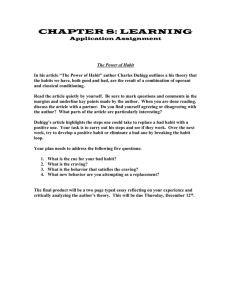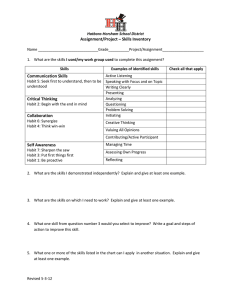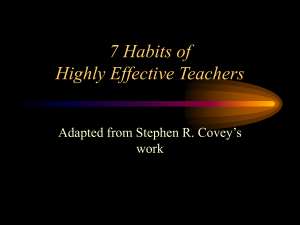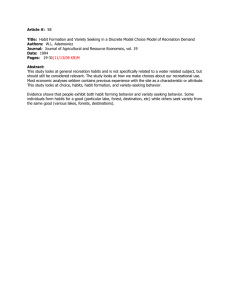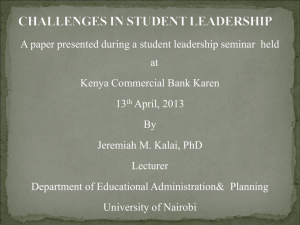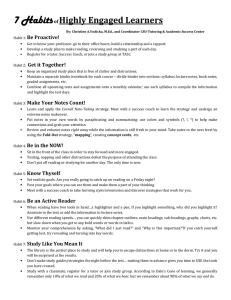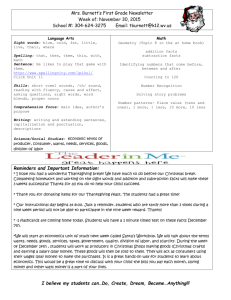Document 14093278
advertisement
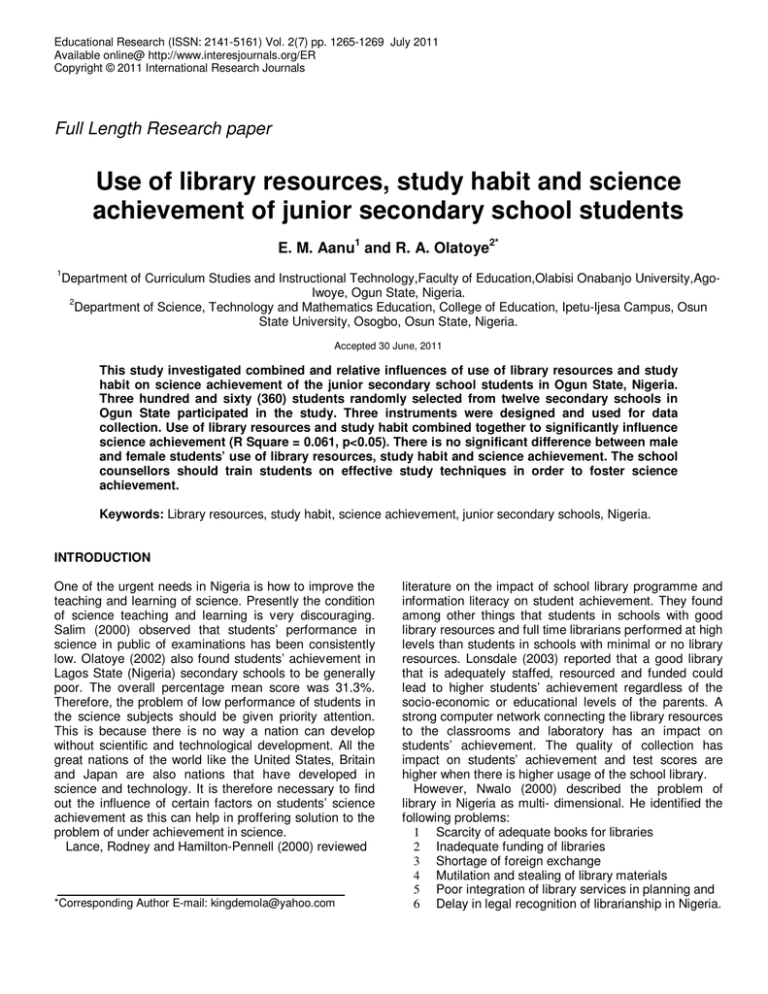
Educational Research (ISSN: 2141-5161) Vol. 2(7) pp. 1265-1269 July 2011 Available online@ http://www.interesjournals.org/ER Copyright © 2011 International Research Journals Full Length Research paper Use of library resources, study habit and science achievement of junior secondary school students E. M. Aanu1 and R. A. Olatoye2* 1 Department of Curriculum Studies and Instructional Technology,Faculty of Education,Olabisi Onabanjo University,AgoIwoye, Ogun State, Nigeria. 2 Department of Science, Technology and Mathematics Education, College of Education, Ipetu-Ijesa Campus, Osun State University, Osogbo, Osun State, Nigeria. Accepted 30 June, 2011 This study investigated combined and relative influences of use of library resources and study habit on science achievement of the junior secondary school students in Ogun State, Nigeria. Three hundred and sixty (360) students randomly selected from twelve secondary schools in Ogun State participated in the study. Three instruments were designed and used for data collection. Use of library resources and study habit combined together to significantly influence science achievement (R Square = 0.061, p<0.05). There is no significant difference between male and female students’ use of library resources, study habit and science achievement. The school counsellors should train students on effective study techniques in order to foster science achievement. Keywords: Library resources, study habit, science achievement, junior secondary schools, Nigeria. INTRODUCTION One of the urgent needs in Nigeria is how to improve the teaching and learning of science. Presently the condition of science teaching and learning is very discouraging. Salim (2000) observed that students’ performance in science in public of examinations has been consistently low. Olatoye (2002) also found students’ achievement in Lagos State (Nigeria) secondary schools to be generally poor. The overall percentage mean score was 31.3%. Therefore, the problem of low performance of students in the science subjects should be given priority attention. This is because there is no way a nation can develop without scientific and technological development. All the great nations of the world like the United States, Britain and Japan are also nations that have developed in science and technology. It is therefore necessary to find out the influence of certain factors on students’ science achievement as this can help in proffering solution to the problem of under achievement in science. Lance, Rodney and Hamilton-Pennell (2000) reviewed *Corresponding Author E-mail: kingdemola@yahoo.com literature on the impact of school library programme and information literacy on student achievement. They found among other things that students in schools with good library resources and full time librarians performed at high levels than students in schools with minimal or no library resources. Lonsdale (2003) reported that a good library that is adequately staffed, resourced and funded could lead to higher students’ achievement regardless of the socio-economic or educational levels of the parents. A strong computer network connecting the library resources to the classrooms and laboratory has an impact on students’ achievement. The quality of collection has impact on students’ achievement and test scores are higher when there is higher usage of the school library. However, Nwalo (2000) described the problem of library in Nigeria as multi- dimensional. He identified the following problems: 1 Scarcity of adequate books for libraries 2 Inadequate funding of libraries 3 Shortage of foreign exchange 4 Mutilation and stealing of library materials 5 Poor integration of library services in planning and 6 Delay in legal recognition of librarianship in Nigeria. 1266 Educ. Res. Study skills are fundamental academic success. This is because a student can only recall what is in the memory. A student who does not give enough time to read may find it difficult to do well in examinations especially where the topics to be covered are many and there is limited time to prepare for examinations. Tschumper (2006) reported that the study skills of the high school students are very poor. He noted that the focus on education has shifted from teaching skills for academic success to covering all the materials in the curriculum in preparation for the mandated standardized tests. Poor performance of students in school have been traced to poor study habit (Bradon, 1996, Olatoye, 2009, Olatoye & Ogunkola, 2008). Bradon (1996) noted that if study skills are not improved students will continue to perform poorly in tests and may not be able to realise their full potential. Students should therefore evolve good study habit skills like note-taking, time management, organizing for a test, recording assignment in assignment note books, leaving regular time to study while removing distraction that come from television or phone call during homework. Availability and use of library resources and effective study habit are therefore important prerequisites to attaining greater achievement in science. This study therefore investigated combined and relative influence of use of library resources and study habit on students’ science achievement in the Junior Secondary Schools in Ogun State. Research Questions 1. To what extent will the use of library resources and study habit taken together predict students’ science achievement? 2. To what extent will the use of library resources alone predict students’ science achievement? 3. To what extent will study habit alone predict students’ science achievement? 4. What are the relationships among use of library resources, study habit and students’ science achievement? 5. Is there any significant difference between male and female students’ i. Use of library resources ii. Study habit and iii. Science achievement? occurred, the researcher cannot manipulate them. This design is very suitable because this study is nonexperimental and the two independent variables, study habit and use of library resources were not manipulated. Target Population and Sample The target population for the study is all the Junior Secondary School students in Ogun State. Twelve secondary schools were randomly selected from the list of secondary schools in each of the four divisions of Ogun State. Random sampling technique was used to select three (3) secondary schools from each division in order to ensure each school had equal chance of being selected. Twelve schools selected from the four divisions in the State were used for the study. Thirty students were randomly selected from the Junior Secondary School III in each school. A sample of three hundred and sixty (360) students was used for the study. Instrumentation Three questionnaires were designed and used to collect data. They are: i. Use of Library Resources Questionnaire (ULRQ) ii. Students’ Study Habit Questionnaire (SSHQ) iii. Students’ Science Achievement Test (SSAT) ULRQ and SSHQ are four-point Likert-type scale. Students were asked to indicate their opinion by ticking any of ‘Strongly Agree,’ ‘Agree’ ‘Disagree’ and ‘Strongly Disagree’ in front of each statement. The ULRQ and SSHQ have 16 and 14 items respectively. Students were not asked to indicate their names on the questionnaires to make the responses anonymous. The initial versions of the instruments were given to experts for suggestions and comments before coming up with the final versions. The Cronbach alpha reliability co-efficients of 0.781, 0.701, 0.776 were obtained for ULRQ, SSHQ and SSAT respectively. SSAT is a 50-item multiple-choice objective test with four options for an item. The items cover all the topics in the Upper Basic Education (Junior Secondary School) Integrated Science syllabus. Data Analysis METHODOLOGY Research Design This study adopted an expost facto research design. In such design, the independent variables have already Data were analyzed using regression analysis for research questions 1 to 3, Pearson product-moment correlation for research question 4 and t-test for research question 5. The research questions were answered using a two-tailed test at 0.05 level of confidence. Aanu and Olatoye 1267 Table 1: Combined influence of use of library resources and study habit on science achievement R = 0.246 R Square = 0.061 Adjusted R Square = 0.55 Standard Error = 6.678 Analysis of variance Sum of squares Regression 1029.061 Residual 15921.728 Total 16950.789 Df 2 357 359 Mean square 514.530 44.599 F 11.537 p 0.000 Remark * *Significant (p<0.05) Table 2: Use of library resources as a predictor of students’ science achievement R = 0.164 R Square = 0.027 Adjusted R Square = 0.024 Standard Error = 6.788 Analysis of variance Sum of squares Regression 457.272 Residual 16493.517 Total 16950.789 Df 1 358 359 Mean square 457.272 46.071 F 9.925 p 0.002 Remark * *Significant (p<0.05) RESULTS Research Question 1 To what extent will the use of library resources and study habit taken together predict students’ science achievement? In table 1, combined influence of use of library resources and study habit accounted for a low but statistically significant 6.1% of the total variance in science achievement (R Square =0.061, p<0.05). Thus, use of library resources and study habit are important predictors of science achievement. These two independent variables are among the factors that can raise student achievement in science. The low percentage only implies that there are many other variables, not considered in this study that can still help to explain variance in science achievement. In other words, there are still many other independent variables that influence students’ science achievement in schools. achievement. (R Square = 0.027, p<0.05). This percentage though statistically significant is very low. Use of library resources is therefore an important variable in science achievement. The low percentage presupposes there are still many variables that can significantly predict achievement in science. Research Question 3 To what extent will study habit alone predict students’ science achievement? In table 3 below, study habit alone accounted for 6.0% of the total variance in students’ science achievement (R Square = 0.060, p<0.05). This percentage though statistically significant is very low. The low percentage presupposes there are still many variables that can significantly predict achievement in science. The fact that the percentage is significant means it is an important predictor of science achievement. Research Question 2 Research Question 4 To what extent will the use of library resources alone predict students’ science achievement? In table 2 above, use of library resources alone accounted for 2.7% of the total variance in science What are the relationships among use of library resources, study habit and students’ science achievement? Each of the variables in table 4 below significantly 1268 Educ. Res. Table 3: Study habit as a predictor of students’ science achievement R = 0.246 R Square = 0.060 Adjusted R Square = 0.058 Standard Error = 6.670 Analysis of variance Sum of squares Regression 1022.461 Residual 15928.328 Total 16950.789 Df 1 358 359 Mean square 1022.461 44.493 F 22.981 P 0.000 Remark * *Significant (p<0.05) Table 4 Relationships among use of library resources, study habit and students’ science achievement Variable Use of library resources Study Habit Science Achievement Use of library resources 1.000 0.235* 0.164* Study Habit Science Achievement 1.000 0.246* 1.000 *Significant (p<0.05) Table 5 Comparison of male and female students’ use of library resources, study habit and students’ science achievement Variable Gender N Mean Std. Dev. Std. Error df t p Remark Use of library resources Male Female Male Female Male Female 181 179 181 179 181 179 30.862 30.480 32.000 31.899 19.149 19.665 8.501 8.339 12.146 12.982 6.638 7.109 0.632 0.623 0.903 0.970 0.493 0.531 358 0.700 0.450 NS 358 0.446 0.656 NS 358 0.726 0.468 NS Study Habit Science Achievement NS = Not Significant (p > 0.05) correlated with every other variable. This implies that there is a significant relationship between any two variables in the table above. Thus, the higher the students’ use of Library, the higher the study habit, the higher the science achievement. Research Question 5 Is there any significant difference between male and female students’ i. Use of library resources, ii. Study habit and iii. Science achievement? There is no significant difference between male and female students’ use of library resources, study habit and students’ science achievement. It should be noted that students’ average performance in science is still below average. The mean scores of achievement of male and female students are 19.149 and 19.665 respectively. The mean scores are below average because the maximum obtainable score in the science test administered is 50. DISCUSSION Use of library resources and study habit combined together to significantly predict student science achievement. Each of the independent variables also significantly predicts science achievement. The significant positive influence of library resources on students’ achievement is not new. Lance, Rodney and Hamilton-Pennell (2000) reported those students’ in schools with good librarian and full time library staff preformed at higher level than students in schools with minimal or no library use. Lansdale (2003) corroborated this report. He found that students in schools adequately staffed, resourced and funded had higher students’ achievement. The positive relationship between library use and study habit has been reported by Dike (2004) and Abareh (1998). Use of library resources encourages good study habit skills. It is therefore logical to expect high positive relationship between study habit, use of library resources and academic achievement as reported in this study. Study habit includes students’ skills for academic Aanu and Olatoye 1269 activities like note-taking, consultation with teachers, time allocation for study and ability to read and cover adequately all topics required for test or examination. No doubt, students need the support of the library to carry out all these important academic activities. Onatola (2004) considered libraries as fundamental to the design and implementation of excellent educational programme. He further explained that the level of support given to library by the government and the public, qualification, experience and personality of library staff are very important in enhancing library roles to students. Dike (2004) identified the roles of libraries to users as provision of learning resources, teaching and education function, promotion of reading and provision of information and literacy education. There seems to be a link between library resources, reading and study habit. Library promotes reading cultures among users. Abareh (1998) observed that librarian and libraries play a vital role in promoting reading habit, which is necessary in the development of a person and nation. Reading is one of the most important means for acquisition of knowledge. It is important to education as everyone is brought into contact with a good library throughout his or her period of learning. Low students’ achievement in science has also been reported by many researchers which include Kevees (1992), Salim (2000) and Adekoya and Olatoye (2011). For example, Keeves (1992) and Olatoye(2002) also reported significant difference between male and female students’ achievement in science. In those studies male students performed significantly better than their female counterparts. In this study, there is no significant difference between male and female students’ science achievement. CONCLUSION AND RECOMMENDATIONS Supply of books to the library should also take care of all the subject areas especially the science subjects. Provision of laboratory equipment is not enough if students do not have where they can relax and read the theoretical bases of all the topics taught in the laboratory. Every good school should have a functional library where students can have access to information and materials that can assist in completion of assignments and preparation for examinations. The school administrators should ensure provision of well-equipped library to foster academic achievement. The counsellors’ also should regularly train the students on effective study techniques to enhance achievement in science. REFERENCES Abareh HM (1998). Public library services in our educational process: The case of Bauchi State. The Trumpeter July 6, p2. Adekoya YM, Olatoye RA (2011). Effect of Demonstration, PeerTutoring, and Lecture Teaching Strategies on Senior Secondary School Students‟ Achievement in an Aspect of Agricultural Science, Pacific Journal of Science and Technology, 12(1): 320-332. A publication of Akamai University, USA BradonJA(1996).PoorStudyHabits.Visit: http:/www.library.thinkquest.0rg / 3354. Resources_Center/Visual_Library/Student_Study_habits/-Dike W (2004). The role of the school librarian in implementing the curriculum. Nigerian School Library J., 5(1): 21-28. Keeves JP (1992). Learning Science in a changing world: Cross National Study of science Achievement. Australia: IEA Office. Lance KC (2000). Measuring up to standard: The impact of school library Programs and Information Literacy in Pennsylvania school. Published by Pennsylvania Department of Education. Office of Commonwealth Libraries. Lance KC (2006). The impact of school library Media Centers on Academic Achievement. Colorado, U.S.: Library Research Service. Lonsdale M (2003). Impact of school libraries on student Achievement: A Review of Research. Published by the Australian School Library Association. Nwalo KIN (2000). Society development and libraries, Ibadan: The Centre for External Studies, University of Ibadan, pp 68. Olatoye RA (2002). A causal model of school factors as determinants of science achievement in Lagos State Secondary Schools. An Unpublished PhD Thesis, University of Ibadan, Ibadan. Olatoye RA (2009). Study Habit, Self-Concept and Science Achievement of Public and Private Junior Secondary School Students in Ogun State, Nigeria, African Research Review. An International Multi-Disciplinary Journal, Ethiopia. 3(3): 492-506. Available at: www.ajol.info Olatoye RA, Ogunkola BJ (2008). Parental Involvement, Study Habit and Science Achievement of Upper Basic Education Students in Ogun State, Nigeria, Afri.J. for the Study of Educ. Issues,1(1&2): 47-53. A Publication of University of Cape Coast, Ghana. Onatola A (2004). Basic of librarianship theory and practice: A guide for beginners: Lagos: Omega Publishers Limited pp 28. Salim B (2000). JAMB result released. The Daily Times July, 27, p 1. Tschumper KS (2000). Study skill instruction in high school: Where O’ where the High School Students’ Study Skill Gone? Published by University of Wisconsinla Crosse Onalaska Community.Visit: www.asla.org.au/research/research…
